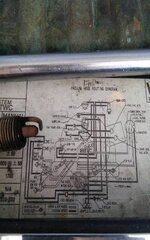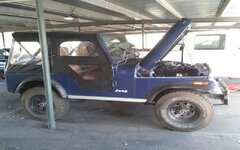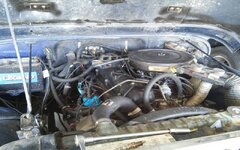83 Cj5 Running too rich
Completely stock down to the emission controls
1983 Jeep CJ5
6 cyl 258
Carb: 3 months old Electronic stepper version of the Carter BBD (California edition?)
Milage: Unknown but PO says 113k speedo is correct. As of now, nothing to insinuate otherwise. Has not been driven much in the last 10 years.
Oil pressure: ~60psi cold, 20 warm at 700 rpm idle
I'm going to start taring down the carb, does anyone know specifically where I would adjust the stepper BBD to make it leaner; for example, could I slightly reduce the clearance in the stepper valve?
This model doesn't seem to have purchasable jets.
Background information for those that choose to read it can be found below. Any suggestions are welcome.
I live at 5k ft altitude, and constantly see altitudes of 10-13kft. Consequently, I'm running extremely rich. The problem is exacerbated in the mourning when cold, presumably due to the choke being active and further restricting airflow.
Symptoms: Perfect idle. Easily starts up in 50F. Fumbles and at low speeds. Wants to shut off then will restart with motion. When coming down a steep mountain, it keeps shutting off and coming back on. I smell gas, gets 6mpg and has no power.
I have the timing set at +16, the high altitude jumper connected, spark gap set at .035, Idle mixture screws set at highest idle @ 700rpm, ran Marvel Mystery through the carb, and new air filter. It still ran poorly. In order to reduce the likely-hood of a vacuum issue I then capped the carbs EGR, and both Manifold Vac. I then bought new line for the line from carb to Distributor.
At this point, I'm thinkin' the computer can't can't compensate for stoichiometric coefficients of 10k ft for long duration, but it still doesn't account for the over rich at more moderate altitudes (5k).
Could it be the Charcoal Canister?
Could it be a spark problem? I was thinking of doing TeamRush mod, but I don't want to do it if it wont help.
The point is I'm running way too rich, and I need to rectify the problem, or my Jeep will continue to be undrivable.
Thank you,
Chris
1983 Jeep CJ5
6 cyl 258
Carb: 3 months old Electronic stepper version of the Carter BBD (California edition?)
Milage: Unknown but PO says 113k speedo is correct. As of now, nothing to insinuate otherwise. Has not been driven much in the last 10 years.
Oil pressure: ~60psi cold, 20 warm at 700 rpm idle
I'm going to start taring down the carb, does anyone know specifically where I would adjust the stepper BBD to make it leaner; for example, could I slightly reduce the clearance in the stepper valve?
This model doesn't seem to have purchasable jets.
Background information for those that choose to read it can be found below. Any suggestions are welcome.
I live at 5k ft altitude, and constantly see altitudes of 10-13kft. Consequently, I'm running extremely rich. The problem is exacerbated in the mourning when cold, presumably due to the choke being active and further restricting airflow.
Symptoms: Perfect idle. Easily starts up in 50F. Fumbles and at low speeds. Wants to shut off then will restart with motion. When coming down a steep mountain, it keeps shutting off and coming back on. I smell gas, gets 6mpg and has no power.
I have the timing set at +16, the high altitude jumper connected, spark gap set at .035, Idle mixture screws set at highest idle @ 700rpm, ran Marvel Mystery through the carb, and new air filter. It still ran poorly. In order to reduce the likely-hood of a vacuum issue I then capped the carbs EGR, and both Manifold Vac. I then bought new line for the line from carb to Distributor.
At this point, I'm thinkin' the computer can't can't compensate for stoichiometric coefficients of 10k ft for long duration, but it still doesn't account for the over rich at more moderate altitudes (5k).
Could it be the Charcoal Canister?
Could it be a spark problem? I was thinking of doing TeamRush mod, but I don't want to do it if it wont help.
The point is I'm running way too rich, and I need to rectify the problem, or my Jeep will continue to be undrivable.
Thank you,
Chris
Last edited:



